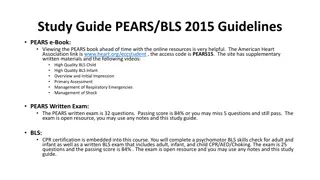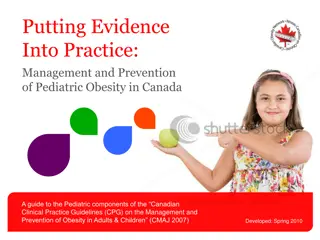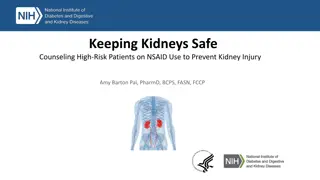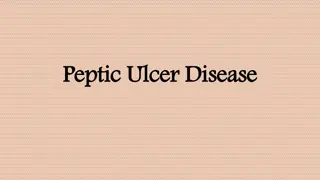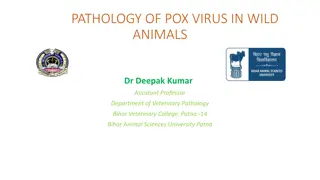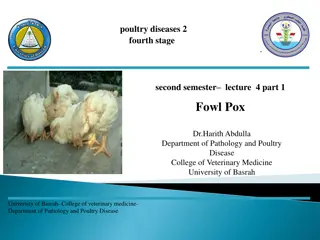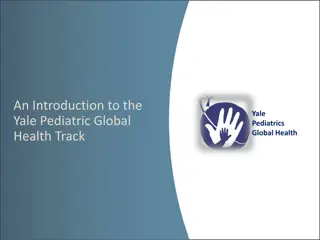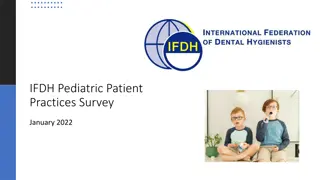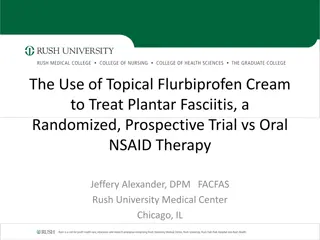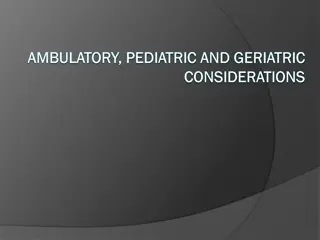NSAID Use in Chicken Pox: Pediatric Considerations and Implications
This study delves into the debate surrounding administering NSAIDs like ibuprofen to children with chicken pox. It addresses the possible risks associated with NSAID use in varicella infections, focusing on the potential worsening of skin infections due to inhibited neutrophil function. The PICO analysis examines the impact of NSAIDs on the development of secondary streptococcal skin infections in pediatric patients with varicella zoster.
Download Presentation

Please find below an Image/Link to download the presentation.
The content on the website is provided AS IS for your information and personal use only. It may not be sold, licensed, or shared on other websites without obtaining consent from the author.If you encounter any issues during the download, it is possible that the publisher has removed the file from their server.
You are allowed to download the files provided on this website for personal or commercial use, subject to the condition that they are used lawfully. All files are the property of their respective owners.
The content on the website is provided AS IS for your information and personal use only. It may not be sold, licensed, or shared on other websites without obtaining consent from the author.
E N D
Presentation Transcript
BEST BETS 12TH J ULY 2 0 1 6
NSAID USE IN CHICKEN POX J A M ES HA R PER CHR I S PHI LLI PS TOM HUTCHI N S ON
CLINICAL SCENARIO -------------------------------- Paediatric placement week Nine year old with chicken pox, some infected lesions. Patient was admitted for intravenous antibiotics. Paediatric consultant asked me if I would advise giving ibuprofen to a child with chicken pox in the community? Leading Question No?
WHY? -------------------------- There are approximately 700,000 cases of chicken pox a year in England and Wales1 Over 90% of people in the UK will contract chicken pox before adolescence2 In children younger than 5 years of age, bacterial skin infection is the most common complication5 But it is rare: 2.8 per 10004 Anecdotally Ibuprofen is very commonly used in paediatric patients for fever both as an over the counter and as a prescribed medication. Ibuprofen is better at bringing down a temperature than paracetamol6
POSSIBLE UNDERLYING MECHANISM ---------------------------------------------- In vitro studies Decreases in neutrophil function after exposure to NSAIDs Specifically aggregation, adherence and degranulation of neutrophils10 Inhibition of prostaglandin synthesis9 In vivo Neutrophils from subjects taking therapeutic doses of ibuprofen, indomethacin, or piroxicam showed profiles of inhibited responses to an infective stimulant8 Ibuprofen study in rats showed decreased survival from surgical wounds and in a cecal ligation and punction model11 Suggestion that NSAIDs may play a role, not only in the cause of varicella-associated skin infections, but also in the general worsening of infections.
PICO ---------------------------------------------- Paediatric Patients with Varicella Zoster Population: The use of NSAIDs Intervention: The use of a placebo/avoidance of NSAIDs Comparator: Development of secondary streptococcal skin infections Outcome:
SEARCH STRATEGY ---------------------------------------------- PubMed/Cochrane Library [varicella] AND [ibuprofen OR NSAID] 140 results of which 14 were relevant and related to skin infections Removed one in French, one in Spanish, one in Portuguese 2 BMJ letters 3 duplicates 1 retrospective cohort study 3 case control studies 1 prospective cohort study 1 commentary
CRITICAL APPRAISAL ---------------------------------------------- Ann Epidemiol. 1997 Oct;7(7):440-5. Ibuprofen and skin and soft tissue superinfections in children with varicella. Choo PW, Donahue JG, Platt R. Pediatrics. 2001 May;107(5):1108-15. Invasive group A streptococcal infection and nonsteroidal antiinflammatory drug use among children with primary varicella. Lesko SM, O'Brien KL, Schwartz B, Vezina R, Mitchell AA. Pediatrics. 1999 Apr;103(4 Pt 1):783-90. A case-control study of necrotizing fasciitis during primary varicella. Zerr DM, Alexander ER, Duchin JS, Koutsky LA, Rubens CE. Br J Clin Pharmacol. 2008 Feb;65(2):203-9. Nonsteroidal anti-inflammatory drug use and the risk of severe skin and soft tissue complications in patients with varicella or zoster disease. Yann Mikaeloff,Abbas Kezouh,and Samy Suissa. Acta Derm Venereol. 2008;88(1):26-30. doi: 10.2340/00015555-0333. Bacterial skin infections in children hospitalized with varicella: a possible negative impact of non-steroidalanti-inflammatory drugs? Dubos F1, Hue V, Grandbastien B, Catteau B, Martinot A. Int J Clin Pharm. 2015 Dec;37(6):975-7. doi: 10.1007/s11096-015-0184-2. NSAIDs in paediatrics: caution with varicella! Durand Let al
Ann Epidemiol.1997 Oct;7(7):440-5. Ibuprofen and skin and soft tissue superinfections in children with varicella. Choo PW,Donahue JG,Platt R. Healthy children under 13 living in Massachusetts, USA No predisposing immunocompromising or dermatological conditions Received care at 11 health centres for soft tissue infections secondary to Varicella Zoster (VZ) Patient Population Retrospective Cohort Study based on Electronic Medical and Pharmacy Records between 1990-1994 Identified through clinical coding as having a soft tissue infection less than 30 days following VZ Ibuprofen use was defined as any Ibuprofen prescription <180 days before the development of VZ Contingency tables used to determine an associated between ibuprofen and soft tissue infection Methods 7013 children identified with varicella zoster, 89 developed soft tissue infections 4 of the 89 had prescriptions for ibuprofen prior to the development of secondary infections No obvious link identified but highlights the need for further research Results/ Conclusions Limited power (<20%) due to infrequency of documented ibuprofen dispensing and skin superinfection Dated study where very basic electronic medical records were used Does not take into account use of NSAIDs which were not prescribed Limitations
Pediatrics.2001 May;107(5):1108-15. Invasive group A streptococcal infection and nonsteroidal antiinflammatory drug use among children with primary varicella. Lesko SM,O'Brien KL,Schwartz B,Vezina R,Mitchell AA. Previously healthy children <19 years admitted with secondary Group A Streptococcal infections (GAS) to hospitals throughout USA Matched with controls who had no secondary infection who lived within the same community Patient Population Prospective, multicentre case-control study in USA between 1996 and 1998 Those with immunocompromisation or contraindication to NSAID use were excluded Hospitalised patients were nominated by infectious disease physicians to be included in the study Information was gathered by structured telephone interviews Methods 52 cases met eligibility criteria with 172 used as controls 18 of the 52 cases of GAS received Ibuprofen vs 36 of the 172 controls Risk of GAS infection was increased in children who had ibuprofen (OR 3.9 95% CI 1.3-12) Therefore there is an association between GAS and Ibuprofen use Results/ Conclusions Difficult to establish cause an effect. Association does not imply causation. Use of telephone interviews increases risk of recall bias Increased likelihood of sampling bias Marked differences in demographics between cases and controls Limitations
Pediatrics.1999 Apr;103(4 Pt 1):783-90. A case-control study of necrotizing fasciitis during primary varicella. Zerr DM,Alexander ER,Duchin JS,Koutsky LA,Rubens CE. Previously healthy children under 13 years of age living in Washington State, USA Developed Necrotising Fasciitis (NF) within 3 weeks of having VZ between 1993 and 1994 Matched with controls who were hospitalised with secondary soft tissue infections other than NF Patient Population Retrospective case control study of patients having been diagnosed with NF 3 weeks following VZ Patients identified through clinical coding of discharge letters Immunocompromised children were excluded Information obtained by medical records review and structured interview with the parents Methods 19 cases of NF complicating VZ were matched with 26 controls 9 of the 19 patients who developed NF had taken ibuprofen (odds ratio 5.0 (1.03-26.6) Suggests an association between ibuprofen and the development of Necrotising Fasciitis Results/ Conclusions 7 of the 9 cases that developed a secondary infection had ibuprofen following the diagnosis of necrotising fasciitis Interviews were conducted up to 12 months following the illness. Increased risk of recall bias. Conducted at a time when parents warned not to give Ibuprofen during VZ in local media Limitations
Br J Clin Pharmacol.2008 Feb;65(2):203-9. Nonsteroidal anti-inflammatory drug use and the risk of severe skin and soft tissue complications in patients with varicella or zoster disease. Yann Mikaeloff,Abbas Kezouh,and Samy Suissa. Nested case control study 1994-2005 11 years of data collection 140 111 had chickenpox Of which 386 developed secondary bacterial skin infections The rate of skin infections associated with NSAID use was increased (rate ratio of 4.9) + = No recall bias, nested - = Observational
Acta Derm Venereol.2008;88(1):26-30. doi: 10.2340/00015555-0333. Bacterial skin infections in children hospitalized with varicella: a possible negative impact of non-steroidalanti- inflammatory drugs? Dubos F1,Hue V,Grandbastien B,Catteau B,Martinot A. Multi centre prospective study 159 children admitted with varicella. 43 of whom developed superadded infections. NSAIDs were associated with onset of superadded infection (p 0.005)
Int J Clin Pharm.2015 Dec;37(6):975-7. doi: 10.1007/s11096-015-0184-2. NSAIDs in paediatrics: caution with varicella! Durand Let al International Journal of Clinical Pharmacy Article summarises that whilst no causal relationship has been definitively demonstrated, an association between NSAID use in varicella and superadded infection, has been found. Advocates that paracetamol remains the safest antipyretic to use in varicella
THE BOTTOM LINE ---------------------------------------------- There is evidence of ibuprofen being an independent risk factor for skin infections. There is evidence of a possible underlying mechanism to support that. However a persistent high fever after varicella infection may lead to ibuprofen use which itself is probably a sign of incipient soft tissue infection. Excess fear of ibuprofen can lead to excess use of paracetamol, which in overdose and especially in children can be hepatotoxic7 Should prescription of NSAIDs be limited in VZV infections?
REFERENCES ---------------------------------------------- 1. 2. 3. 4. 1 DTB (2005a) Chickenpox, pregnancy and the newborn.Drug & Therapeutics Bulletin43(9), 69-72. DH (2012) Immunisation against infectious disease- "The Green Book". Chapter 34 - Varicella.Department of Health. www.dh.gov.uk Lichenstein, R. (2006) Pediatrics, chicken pox or varicella.emedicineWebMD. Yann Mikaeloff,Abbas Kezouh,and Samy Suissa. Nonsteroidal anti-inflammatory drug use and the risk of severe skin and soft tissue complications in patients with varicella or zoster disease. Br J Clin Pharmacol. 2008 Feb;65(2):203-9. Guess, H.A., Broughton, D.D., Melton, L.J. and Kurland, L.T. (1986) Population-based studies of varicella complications.Pediatrics78(4 Pt 2), 723-727. Purssell E. Treating fever in children: paracetamol or ibuprofen? Br J Community Nurs. 2002 Jun;7(6):316-20. Ranganathan SS, Sathiadas MG, Sumanasena S, Fernandopulle M, Lamabadusuriya SP, Fernandopulle BM. Fulminant hepatic failure and paracetamol overuse with therapeutic intent in febrile children. Ind J Pediatr2006;73:871-5 Kaplan HB, Edelson HS, Korchak HM, Given WP, Abramson S, Weissman G. Effects of non-steroidal anti-inflammatory agents on human neutrophil functions in vitro and in vivo. Biochem Pharmacol. 1984;33:371 8 Giagoudakis G, Markantonis SL. Relationships between the concentrations of prostaglandins and the nonsteroidal antiinflammatory drugs indomethacin, diclofenac, and ibuprofen. Pharmacotherapy. 2005;25:18 25 Venezio FR, DiVincenzo C, Pearlman C, Phair JP. Effects of the newer nonsteroidal anti-inflammatory agents, ibuprofen, fenoprofen, and sulindac, on neutrophil adherence. J Infect Dis. 1985;152:690 4. Dong YL, Fleming RY, Yan TZ, Herndon DN, Waymack JP. Effect of ibuprofen on the inflammatory response to surgical wounds. J Trauma.1993;35:340 3 5. 6. 7. 8. 9. 10. 11.


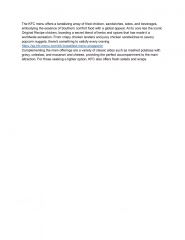


![Halal_Chicken_from_Brazil-_Ensuring_Quality_and_Authenticity[1]](/thumb/86918/halal-chicken-from-brazil-ensuring-quality-and-authenticity-1.jpg)


